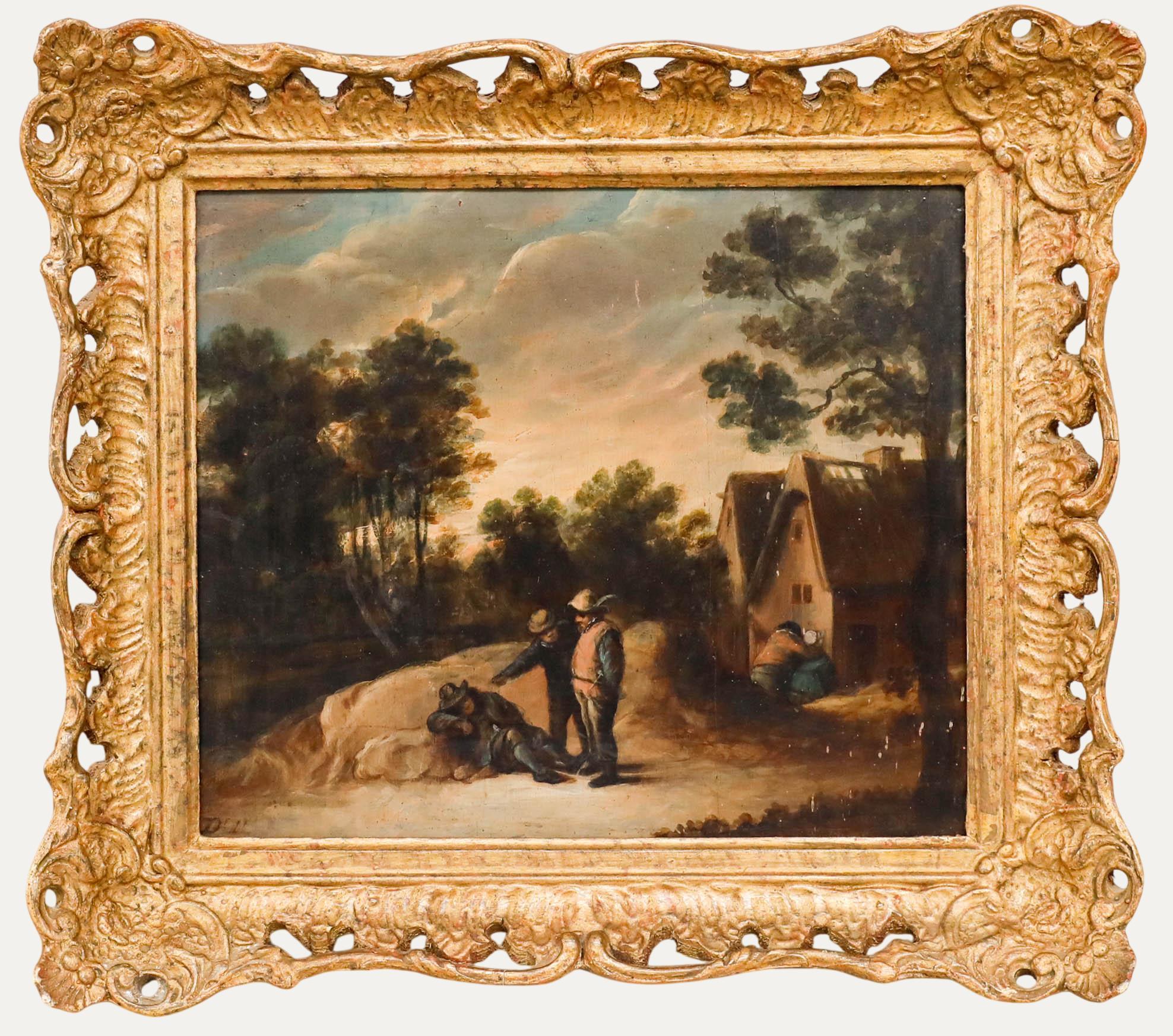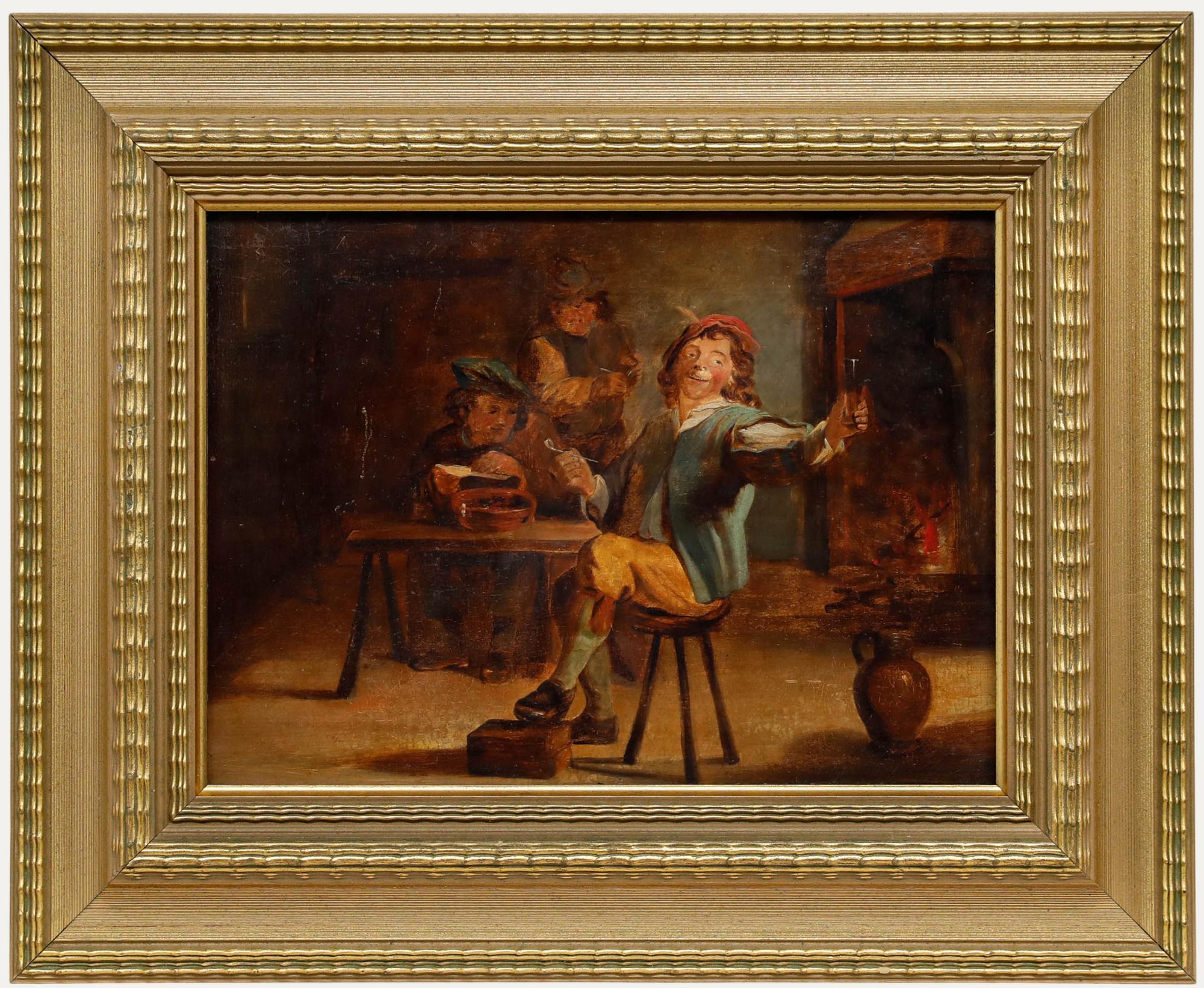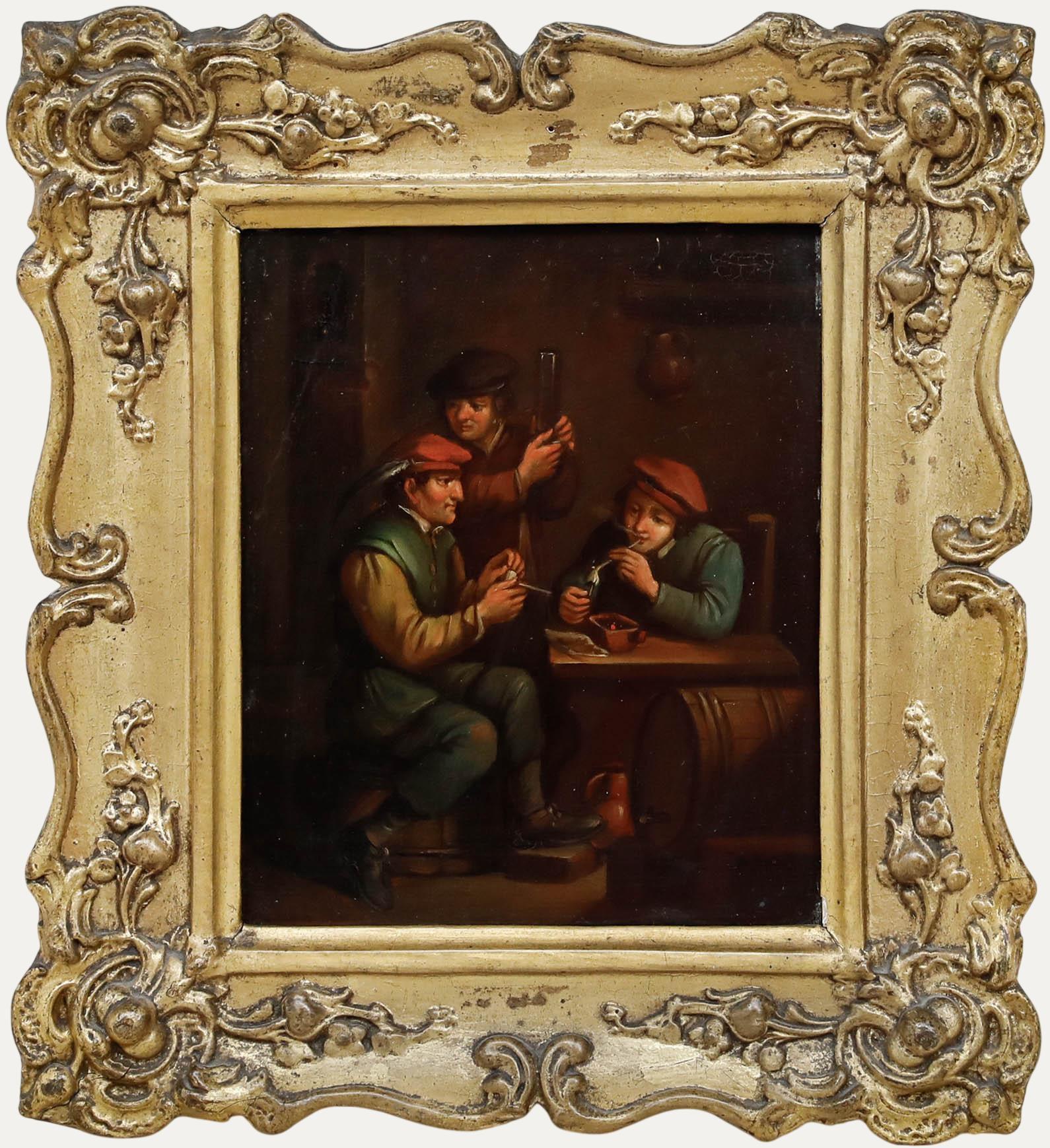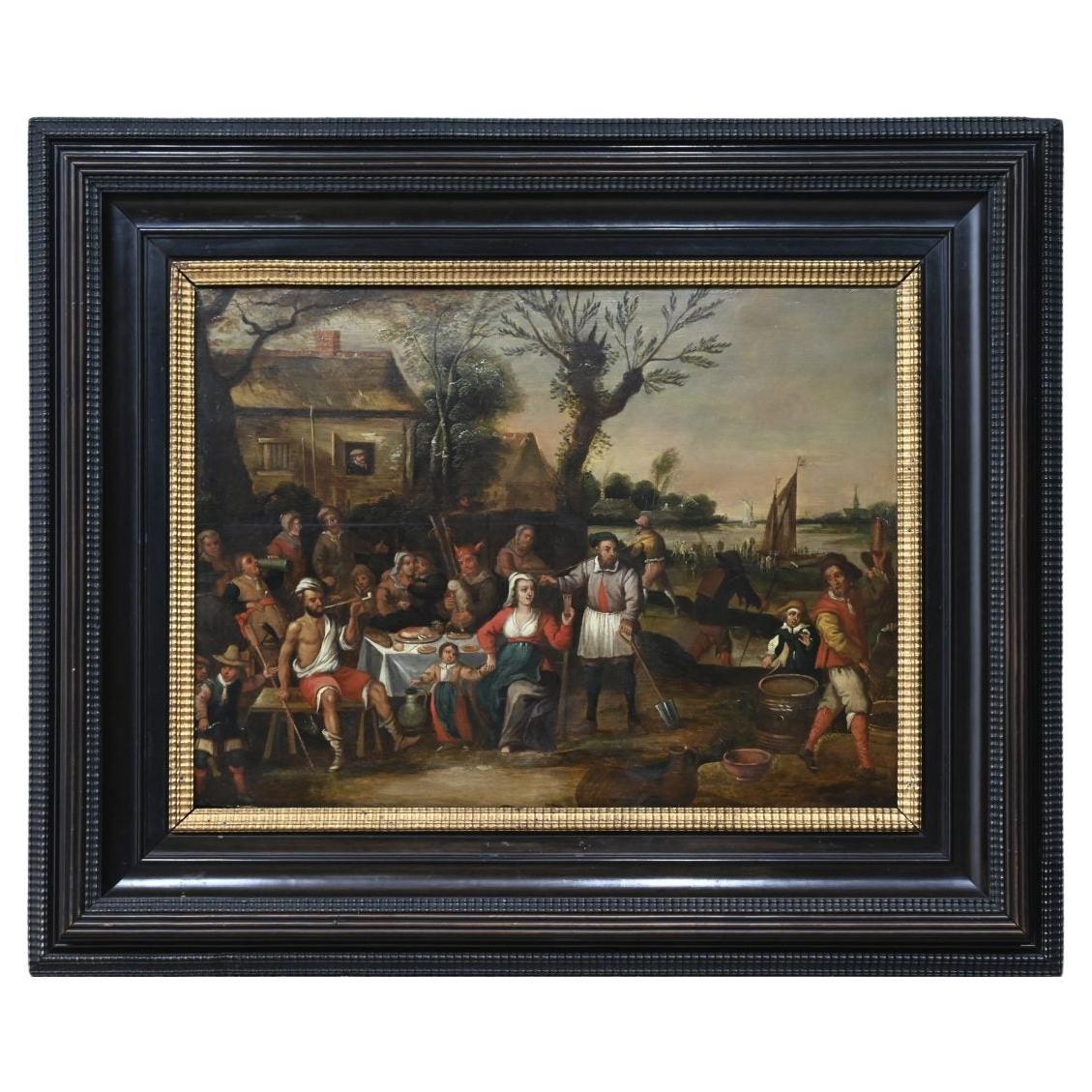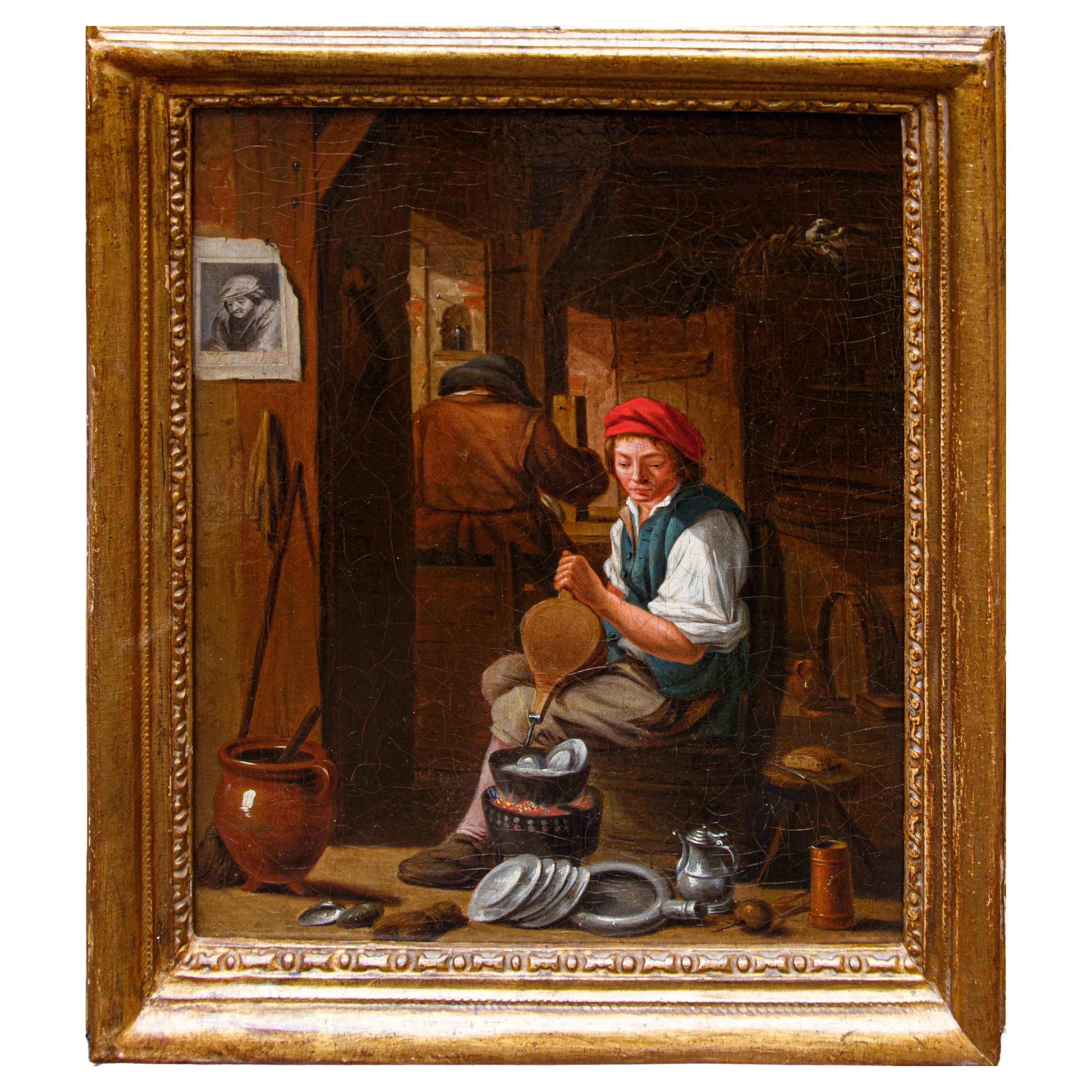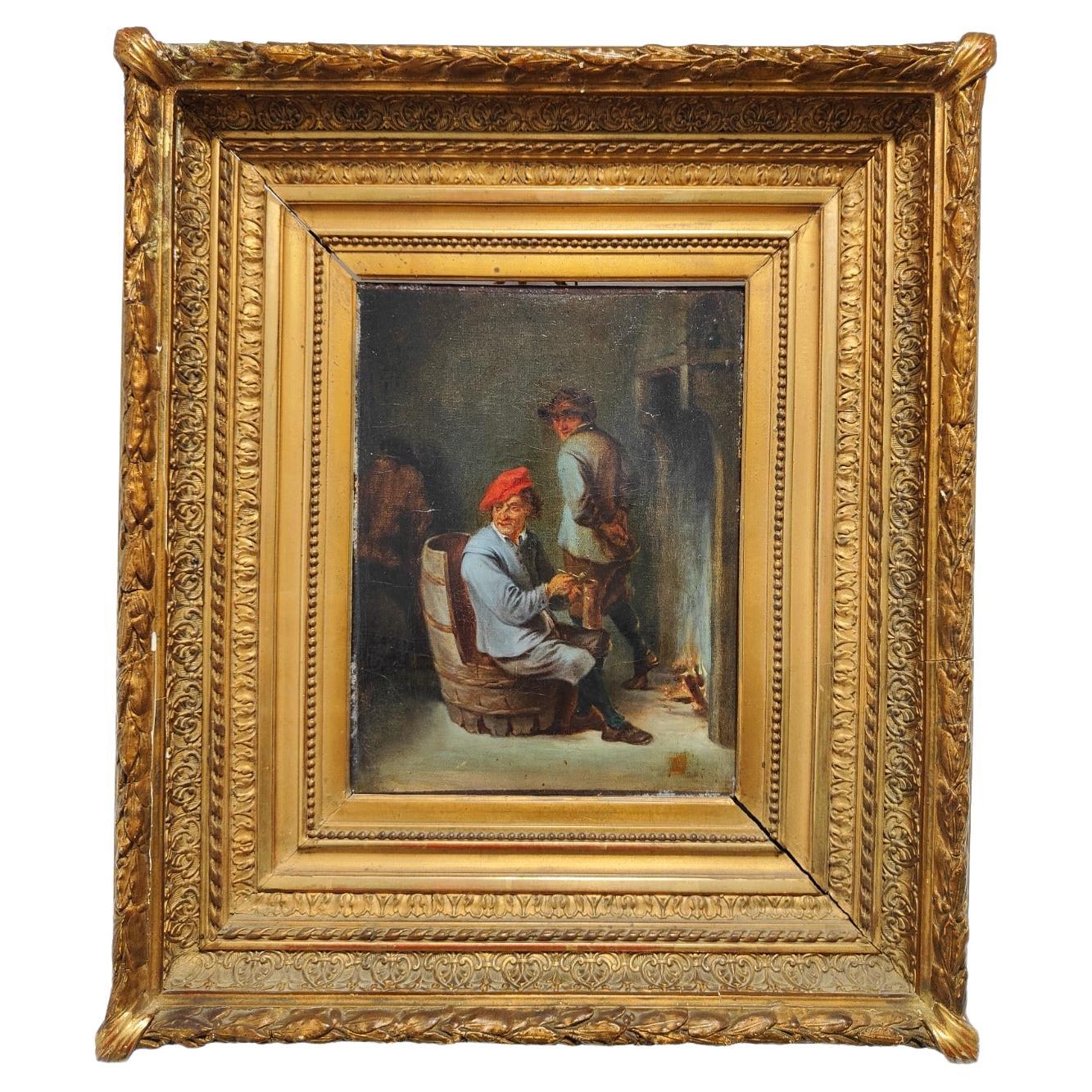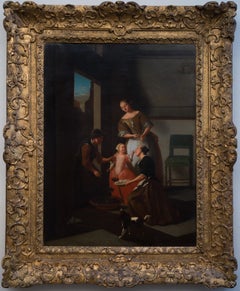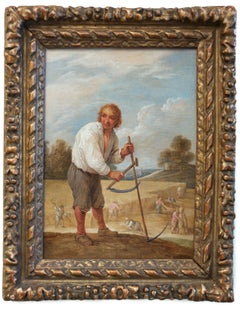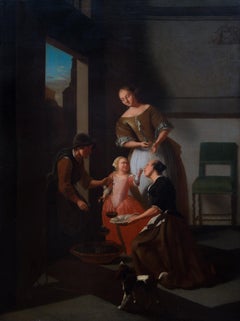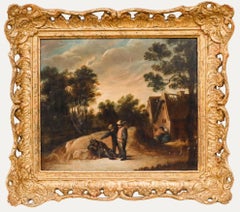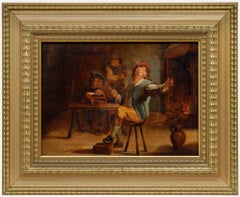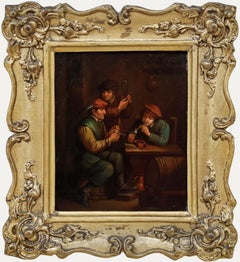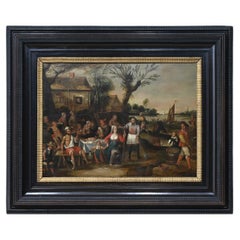Items Similar to A Peasant Removing a Plaster: The Sense of Touch. By a Follower of David Teniers
Video Loading
Want more images or videos?
Request additional images or videos from the seller
1 of 7
A Peasant Removing a Plaster: The Sense of Touch. By a Follower of David Teniers1700 s
1700 s
$7,629.34
£5,761.52
€6,450
CA$10,671.54
A$11,678.15
CHF 6,124.66
MX$139,578.75
NOK 77,292.83
SEK 72,104.88
DKK 49,132.94
About the Item
David Teniers the Younger (1610-1690) Follower of
A Peasant Removing a Plaster: The Sense of Touch
signed T on the table
oil on panel
panel size 7,20 x 5,55 inches (18,3 x 14,4 cm)
frame 11,22 x 9,84 inches (28,5 x 25 cm)
oak frame professionally handmade 2021
Provenance:
Old Christie's stamp on the back;
Private collection Poland;
Desa Auction Poland, 6 October 2020, Lot 55.
- Creation Year:1700 s
- Dimensions:Height: 11.23 in (28.5 cm)Width: 9.85 in (25 cm)
- Medium:
- Movement & Style:
- After:David Teniers the Younger (1610 - 1690, Flemish)
- Period:
- Condition:Slightly yellowed varnish. Retouches in the sky and in some small places. Gives an overall good impression. Handmade oak frame from 2021.
- Gallery Location:Stockholm, SE
- Reference Number:1stDibs: LU144528263032
About the Seller
5.0
Platinum Seller
Premium sellers with a 4.7+ rating and 24-hour response times
Established in 2020
1stDibs seller since 2020
220 sales on 1stDibs
Typical response time: 1 hour
Associations
International Confederation of Art and Antique Dealers' Associations
- ShippingRetrieving quote...Shipping from: Stockholm, Sweden
- Return Policy
More From This Seller
View AllThe Grape Seller by Jacob Ochtervelt (Workshop), Oil on Canvas, Period Frame
Located in Stockholm, SE
Jacob Ochtervelt (Workshop)
The Grape Seller
oil on canvas
unframed: 80.7 x 61 cm.; 31 ¾ x 24 in.
framed: 109.5 x 89 cm.; 43 1/8 x 35 in.
Essay:
Th...
Category
1660s Dutch School Interior Paintings
Materials
Canvas, Oil
$33,119 Sale Price
20% Off
Free Shipping
Peasants in a Cornfield (Boer in het veld) by David Teniers the Younger
By David Teniers the Younger
Located in Stockholm, SE
Remembering the magic of everyday life moments in the art of David Teniers:
The art of David Teniers the Younger (1610–1690) coincided with the heyday of the Flemish Baroque and cap...
Category
Late 17th Century Old Masters Landscape Paintings
Materials
Canvas, Oil
Peasants in a Cornfield (Boer in het veld) by David Teniers the Younger
By David Teniers the Younger
Located in Stockholm, SE
Remembering the magic of everyday life moments in the art of David Teniers:
The art of David Teniers the Younger (1610–1690) coincided with the heyday of the Flemish Baroque and captured a great variety of motifs of his time. In this painting of a seemingly simple peasant scene lies keys to understanding both the imaginative mind of Teniers as well as why this time period produced some of the most iconic works in all of art history.
As indicated by the name, Teniers was more or less born into his profession. As the son of David Teniers the elder, himself a painter who studied under Rubens, the younger David received training in art from a very young age and had no less than three brothers who also became painters. Because of his father’s frequent financial failures that even at times saw him imprisoned, David the younger helped to rescue the family from ruin through painting copies of old masters. Essentially, the young Teniers was confronted with painting as both a passion and creative expression as well as a necessity during difficult times, an experience that would shape much of his capacity and sensitivity in his coming life.
Despite the hardships, the talent and determination of Teniers was recognized and quickly expanded his possibilities. He had already spent time in France and possibly also England when he was hired by his father’s former teacher Rubens to help with a prestigious commission with mythological paintings, now considered lost, for Philip IV the king Spain. In 1644–54 Teniers was appointed dean of the Antwerp Guild of Saint Luke, manifesting his esteemed position within the artistic community. A few years afterwards he took an important step when relocating to Brussels, where Teniers yet again found new career opportunities that would prove to be very successful.
As the keeper of the collections of Archduke Leopold Wilhelm, a role similar to what we now refer to as an art advisor, Teniers purchased hundreds of important artworks that manifested the prominent status of the Archduke’s collection while at the same time providing an unusual access to inspiration and knowledge for Teniers himself. Since he kept on painting during the same time, his creative scope must have seemed almost bewildering in the great variety of images and stories that he surrounded himself with.
Regardless of how glamorous and culturally stimulating the career of Teniers was, he was as open to the charm and existential importance of everyday life as he was to works of great masters and luxurious collectibles. In his impressive repertoire of genres with everything from exquisite royal portraits, interiors, landscapes and history paintings he always added something new and inventive, highlighting the possibilities of art and importance of an experimental and intuitive mind. It is difficult to single out one aspect or genre to summarize his legacy, since it lies much more in the broad virtuosity across many motifs, although he is particularly remembered for farm scenes and meticulously depicted interiors where other paintings and artworks are captured with an astonishing precision. However, the fact that he is still today one of the most known and celebrated names of the Dutch Golden Age is a proof to the magic of his work, which continues to spark dialogue and wonder in the contemporary viewer of his works.
The farm boy in the field in this painting, which likely dates to the mature part of his career, is a wonderful entry into the mind of Teniers. In the tightly cropped motif, we see him standing right in the middle of the busy harvest when men, women and everyone capable were sent out in the field to collect the crop that formed the very core of their diet and survival. In the background we see a fresh blue sky interspersed with skillfully painted clouds, some trees reaching their autumnal colours and in the far distance the glimpse of a small church and village. The presence of a church in a landscape, so typical of Dutch art, served both a symbolic and visual function as a representation of faith while at the same time defining scale and distance.
In the field, the work is in full action with the farmers spread out in various positions, all in the midst of hard and sweaty labour. While they are portrayed as having nothing else than the work on their mind, our farm boy seems to have his attention directed elsewhere. Standing there with his white, half open shirt, flowy curls and strong, sturdy body; his gaze is directed away, out of the picture and the scythes in his hands. He looks almost smirking, expressed with tremendous subtlety in the slight smile of his lips and big eyes, being just in the middle of losing focus on the work. What is it that steals his attention? What has he seen, or realized, or felt – to break him free of the arduous task of harvesting, if but for a moment?
Here starts the wondering and the questions that are the hallmark of a great piece of art. Instead of explicitly locking in the motif in overly clear symbolism Teniers has chosen an open ended, subtle yet striking moment for us to consider. While it of course can be related to numerous other farm scene depictions of this time, and clever usages of gazes and real-life scenes to underscore various moral or symbolic meanings, the painting can be much more of a contemplation than an explanation or illustration. The ordinary nature and understated yet emotionally textured composition of the motif gives greater space for our own reactions and thoughts. Has he seen a pretty farm girl just passing by? Is he fed up with the farm life, joyously dreaming away for a minute, imagining another future? Or is he simply in need of distraction, looking away and ready for anything that can steal his attention?
One quality that never seem to have escaped Teniers was that of curiosity. During all of his career he constantly investigated, expanded and experimented with not only the style and technique of painting, but with the vision of art itself. Being credited with more or less introducing farm motifs for a broader audience not only tells us of his ability to understand the demand for different motifs, but the sensitivity to transform seemingly ordinary parts of life into deep aesthetic experiences, far beyond their expected reach. The farm boy in this painting is, of course, exactly that. But with the help of one smirk the entire picture is charged with a different energy, awakening many contrasts and relationships between the calm landscape, the hard work and his own breach of effectivity, holding sharp scythes while thinking or seeing something else.
It is no wonder Teniers chose to work with farm scenes as a way of investigating these intricate and delicate plays on expectations and surprises, clarity and ambivalence. It invites us to an appreciation of human everyday life that connects us with the people of 17th century...
Category
Late 17th Century Old Masters Landscape Paintings
Materials
Canvas, Oil
The Grape Seller - Workshop of Jacob Ochtervelt
Located in Stockholm, SE
Jacob Ochtervelt (Workshop)
The Grape Seller
oil on canvas
unframed: 80.7 x 61 cm.; 31 ¾ x 24 in.
framed: 109.5 x 89 cm.; 43 1/8 x 35 in.
Essay:
This captivating piece, originating from the studio of the revered Dutch artist Jacob Ochtervelt, mirrors the composition of a signed and dated 1669 canvas by Ochtervelt that is presently housed in the Hermitage museum. Its subject, "The Grape Seller" immerses us in a typical 17th-century interior, replete with characters from various strata of society.
At the center, a fruit vendor is depicted bending over to weigh grapes for the buyer. A child hands some of the grapes to her mother to taste, their attentive maid standing by. The backdrop showcases typical Ochtervelt details: a hint of the city visible through the doorway, light filtering in through an overhead window, and a playful dog at their side.
The exquisite quality of the piece is evident in the minutiae, such as the intricate detailing of the mother's earring, which in reality spans only a few millimeters yet boasts impressive attention to detail. Initially, Sotheby's considered this work to be an autograph piece by Ochtervelt. But due to some uncertainty, it was auctioned as Workshop of Jacob Ochtervelt. On the other hand, the esteemed Cabinet Turquin in Paris leans toward attributing the piece directly to Jacob Ochtervelt himself.
The painting is framed in an authentic period frame, which has been delicately restored by Stockholm's Förgyllning och Bildhuggeri. The frame retains its age-old patina and, while in used condition, has minor imperfections adding to its charm.
Another interesting thing worth to mention is the painting's provenance. It was once owned by the 1st Viscount Rothermere (1868-1940), the founder of the Daily Mail and Daily Mirror...
Category
17th Century Old Masters Interior Paintings
Materials
Canvas, Oil
Abraham and the Sacrifice of His Son Isaac by Adriaen Van Stalbemt, C. 1605-1610
Located in Stockholm, SE
Artist: Adriaen van Stalbemt (Stalbempt) 1580-1662
Title: Abraham and the Sacrifice of His Son Isaac “Das Opfer des Abraham”
According to the Old...
Category
Early 1600s Old Masters Landscape Paintings
Materials
Copper
The Card Players by a Flemish 1600s Artist
By Flemish School, 17th Century
Located in Stockholm, SE
Flemish 1600s School
The Card Players
oil on oak panel
panel dimensions 22.5 x 20 cm
frame included
Provenance:
From a Swedish private collection.
Condition:
Flat and stabl...
Category
17th Century Old Masters Figurative Paintings
Materials
Oak, Oil, Panel
You May Also Like
Manner of David Teniers the Younger (1610-1690) - Oil, Sleeping on the Job
Located in Corsham, GB
Set against a rural backdrop, this amusing scene depicts two men standing over a third figure who lies sleeping against a rock. In the manner of David Teniers. Monogrammed 'DT' to th...
Category
21st Century and Contemporary Figurative Paintings
Materials
Oil
Manner of David Teniers the Younger (1610-1690) - 19th Century Oil, A Toast
Located in Corsham, GB
A charming 19th century oil in the manner of David Teniers the Younger (1610-1690). Teniers was best known for his representations of peasant life. Unsigned. Well presented in a gilt...
Category
19th Century Figurative Paintings
Materials
Oil
Follower of David Teniers (1610-1690) - 20th Century Oil, Tavern Scene
Located in Corsham, GB
An accomplished tavern scene in the Flemish style, depicting three men smoking and drinking in a lively interior. The painting embodies the essence of Golden Age genre painting and i...
Category
20th Century Figurative Paintings
Materials
Oil
Follower of David Teniers the Younger, Oil on Panel of a Village Feast
Located in Leuven, Vlaams Gewest
Beautiful 17th century oil on a cradled panel, Flemish School. A village feast near a lake. Condition improved and a join in the center of the panel has been reinforced. Notes on the...
Category
Antique 17th Century Belgian Paintings
Materials
Wood, Paint
Circle of David Teniers (Antwerp, 1610 - Brussels, 1690), Interior with figures
By David Teniers the Younger
Located in Milan, IT
Circle of David Teniers (Antwerp, 1610 - Brussels, 1690)
Interior with figures of commoners
Oil on canvas, 37 x 27 cm
Framed, 48 x 37 cm
David Teniers the Younger (Antwerp, Dece...
Category
Antique 17th Century Dutch Other Paintings
Materials
Canvas
Small Oil David Teniers the Younger
By David Teniers the Younger
Located in Madrid, ES
Small oil signed David Teniers the Younger (Antwerp, December 15, 1610 – Brussels, April 25, 1690)
David Teniers the Younger (Antwerp, December 15, 1610 – B...
Category
Antique 17th Century Dutch Baroque Paintings
Materials
Paint
